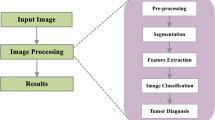Abstract
Brain tumor is one form of brain abnormalities that affects the brain tissues. Magnetic resonance imaging (MRI) is the most popular imaging modality that capture and preserve greatest quality brain image with rich information that provides anatomical structures and internal contents of the brain. It is very challenging in the part of the radiologist to detect the abnormal structures of human brain using clinical expertise and manual image identification methods. Computer-assisted diagnosis (CAD), on the other hand, helps in early identification of brain disorders much faster and easier. In this paper, we proposed and studied a support vector machine (SVM)-based classifier model that implemented a hybrid feature extraction and reduction technique to categorize an input MRI images as normal or tumorous. The model initially implements two-dimensional discrete wavelet transform (2D-DWT) to extract the features of given input image followed by principal component analysis (PCA) to minimize the dimensions of extracted features. The experiments were conducted with 400 MR images comprising of 160 normal and 240 abnormal MRIs with brain tumors. Classifications were performed with five traditional classifiers, namely SVM, random forest, logistic regression, backpropagation neural network (BPNN), and K-nearest neighbor (KNN). On evaluating the classifier models, the proposed SVM-based model achieved better performance compared to the rest of classifiers in terms of accuracy, specificity and sensitivity, and the area under curve (AUC) values.
Access this chapter
Tax calculation will be finalised at checkout
Purchases are for personal use only
Similar content being viewed by others
References
Bashayer Fouad, M.: Automatic classification of brain tumor and Alzheimer’s disease in MRI. In: Science Direct Procedia Computer Science, vol. 163, pp. 74–84 (2019)
John, W.C.: Handbook of MRI technique, 4th edn. Wiley and Sons, (2014)
El-Dahshan, E-S.A. Hosny, T., Salem, A-B. M.: Hybrid intelligent techniques for MRI brain images classification. Digital Signal Process. 20, 433–441 (2010)
Rogowsky, J.: Overview and fundamentals of medical image segmentation. In: Handbook of medical imaging, processing and analysis, vol. 194. IEEE, pp. 69–85 (2000)
Kaplan, K., Yilmaz, K.: Data pre-processing techniques in data mining. In: Medical Hypothesis, vol. 139, pp. 9866–9877 (2020)
Hemarith, D., Anitha, J.: Modified genetic algorithm approaches for classification of abnormal MRI brain tumor images. Appl. Soft Comput. 75, 21–28 (2018)
Patnaik, L.M., Chaplot, S., Jagannathan, N.R.: Classification of magnetic resonance brain images using wavelets as input to support vector machine and neural network. Biomed. Signal Process. Control 1(1), 86–92 (2006)
Ghazali, K.H., Mansor F.H., Mustafa, M, Hussain, A.: Feature extraction technique using discrete wavelet transform for image classification. In: 5th Student Conference on Research and Development, Selangor, (Malaysia), pp. 1–4 (2007)
Sergeto, T.: Principal component analysis for feature extraction and NN pattern recognition in sensor monitoring of chip form during turning. CIRP J. Manuf. Sci. Technol. 7, 202–209 (2014)
Di Ruberto, C., Putzu, L.: A feature-learning framework for histology images classification. In: Emerging Trends in Applications and Infrastructures for Computational Biology, Bioinformatics and Systems, vol. 18, pp 125–136 (2016)
Salankar, S., Nandpuru, H., Bora, V.R.: MRI brain cancer classification using support vector machine. In: IEEE Students’ Conference on Electrical, Electronics and Computer Science, Bhopal, pp. 1–6 (2017), https://doi.org/10.1109/SCEECS.2014.6804439
https://www.kaggle.com/sartajbhuvaji/brain-tumor-classification-mri
Pati, S.P., Mishra, D.: Classification of brain MRIs using improved firefly algorithm-based ensemble model. Int. J. Innov. Technol. Exploring Eng. 8(5), 599–604 (2019)
Author information
Authors and Affiliations
Corresponding author
Editor information
Editors and Affiliations
Rights and permissions
Copyright information
© 2022 The Author(s), under exclusive license to Springer Nature Singapore Pte Ltd.
About this paper
Cite this paper
Woldeyohannes, G.T., Pati, S.P. (2022). Brain MRI Classification for Detection of Brain Tumors Using Hybrid Feature Extraction and SVM. In: Mishra, D., Buyya, R., Mohapatra, P., Patnaik, S. (eds) Intelligent and Cloud Computing. Smart Innovation, Systems and Technologies, vol 286. Springer, Singapore. https://doi.org/10.1007/978-981-16-9873-6_52
Download citation
DOI: https://doi.org/10.1007/978-981-16-9873-6_52
Published:
Publisher Name: Springer, Singapore
Print ISBN: 978-981-16-9872-9
Online ISBN: 978-981-16-9873-6
eBook Packages: Intelligent Technologies and RoboticsIntelligent Technologies and Robotics (R0)




